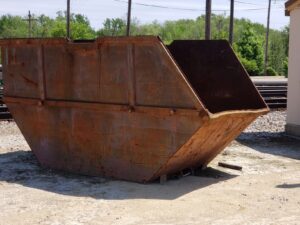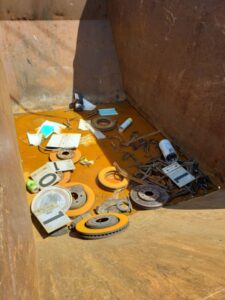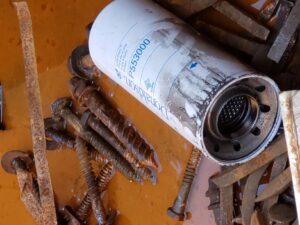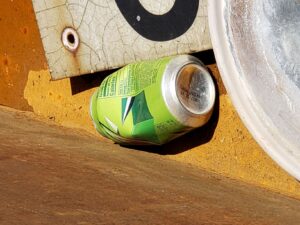Just another skip bin in an industrial setting. Nothing to see here. But I always have to look inside.
At first look, nothing seems amiss: Mostly empty. Some rain water. A few pieces of what appears to be metal scrap.
But look closer. In addition to some legitimate scrap metal I see the following:
- Unpunctured aerosol can
- Undrained used oil filter
- Aluminum can
- And (not a subject for this article, but important nonetheless) accumulated storm water contaminated with rust.
The first two items represent a potential violation of the regulations of Resource Conservation and Recovery Act (RCRA) enforced by the U.S. Environmental Protection Agency (USEPA) and state environmental agencies if that state has an authorized hazardous waste program. The third item is just bad practice. The last is a potential violation of USEPA’s storm water pollution prevention regulations under the Clean Water Act (CWA). Let’s take a closer look.
|
Interested in a Webinar that covers this topic, and more! |
What is scrap metal?
It is defined at 40 CFR 261.6(c)(6):
“Scrap metal” is bits and pieces of metal parts (e.g., bars, turnings, rods, sheets, wire) or metal pieces that may be combined together with bolts or soldering (e.g., radiators, scrap automobiles, railroad box cars), which when worn or superfluous can be recycled.
Also, scrap metal is intended to be recycled so it must have significant metal content, more than 50% per RO 13356.
Any of the items in the image could meet the above definition of scrap metal. And, it appears to me they are destined for recycling.
Per §261.1(c)(11-12) scrap metal may also be “Home scrap metal” or “Prompt scrap metal”:
“Home scrap metal” is scrap metal as generated by steel mills, foundries, and refineries such as turnings, cuttings, punchings, and borings.
“Prompt scrap metal” is scrap metal as generated by the metal working/fabrication industries and includes such scrap metal as turnings, cuttings, punchings, and borings. Prompt scrap is also known as industrial or new scrap metal.
Nothing in the skip bin looks like home scrap metal or prompt scrap metal.
So, scrap metal for recycling. No problem right? Well…
Pursuant to §261.2 – Table 1, a scrap metal that is not excluded under 40 CFR 261.4(a)(13) is a solid waste (and then likely a hazardous waste) even when it is recycled by reclamation. Read this article: The Scrap Metal Exclusion From Solid Waste 40 CFR 261.4(a)(13) for more in-depth identification of scrap metal excluded under 40 CFR 261.4(a)(13), but for the purposes of this article it is:
- Scrap metal that has been or is being processed for recycling at a scrap yard.
- Home scrap metal and prompt scrap metal when not processed.
USEPA believes this excluded scrap metal has inherent value and will be managed without damage to the environment regardless of the exclusion. (62 FR 26011)
The scrap metal in the skip bin is not excluded at §261.4(a)(13) and is therefore a solid waste (and likely a hazardous waste).
That brings us to the scrap metal exemption!
§261.6(a)(3)(ii) exempts from all regulation scrap metal not excluded at §261.4(a)(13) as long as it is destined for legitimate recycling. So we’re back to the contents of the skip bin being exempt from all RCRA hazardous waste regulations, great! But, the exemption does not apply to all aerosol cans or all used oil filters.
Management of used Aerosol Cans:
USEPA has struggled with determining the hazardous characteristics of aerosol cans. For a while USEPA’s position was that even empty aerosol cans could be a hazardous waste due to the characteristic of reactivity (D003). (RO 11782)
Regardless of the characteristic of reactivity, a used aerosol can may be a hazardous waste for other reasons:
- Characteristic of ignitability (D001). Either the propellant or the product to be expelled may be a flammable gas.
- Characteristic of corrosivity (D002). Aerosol products such as oven cleaner may be corrosive.
- Characteristic of toxicity (D004-D043). Several of the toxins identified at §261.24 may be contained in an aerosol can at concentrations above the regulatory threshold.
- Commercial chemical product (P-codes or U-codes). If the aerosol is not empty as defined at §261.7 and it contains a commercial chemical product listed at §261.33.
It is the responsibility of the generator to determine if their aerosol cans – or any other waste generated – are a hazardous waste.
I suspect this aerosol can would be a hazardous waste at the point of disposal because either its propellant or its contents are a flammable compressed gas and therefore has the characteristic of ignitability (D001).
However:
However, a steel aerosol can that does not contain a significant amount of liquid would clearly meet the definition of scrap metal…and thus would be exempt from RCRA regulation…if it were to be recycled. (RO11782)
Clearly this determination is subjective. What is a ‘significant amount of liquid’ to you may differ from the opinion of a USEPA or state inspector. RO 11782 once again provides guidance:
Aerosol cans that have been punctured…and drained…would not contain significant liquids.
So. Punctured and drained means no significant liquids. No significant liquids means the aerosol – no matter its propellant or contents – meets the definition of scrap metal. Scrap metal is eligible for the scrap metal exemption and thus not subject to RCRA regulation.
|
Contact me with any questions you may have about the generation, identification, management, and disposal of hazardous waste Daniels Training Services, Inc. 815.821.1550 |
Let’s take a closer look at that aerosol can.
Distinct from all of the above, on 02.07.20 USEPA regulations went into affect allowing the management of aerosol cans – punctured and unpunctured – as a universal waste. Management of aerosol cans as a universal waste requires closed containers that are labeled and dated, limited on-site accumulation, employee awareness training, and more. This aerosol can does not appear to be managed according to the universal waste regulations either.
This image shows (to me) a hazardous waste or universal waste (aerosol can containing a significant amount of liquid) in an unlabeled, uncovered container (the skip bin), with no marked date of initial accumulation, no indication of the hazards… I doubt there are records of weekly inspections or trained personnel either. Trivial as it may seem, this one aerosol can may be a significant violation of Federal and state regulations.
Management of Used Oil Filters:
Depending on their material of construction and whether or not they have been drained, most used oil filters are excluded from the RCRA regulations. If not, they may be eligible for management as a used oil per 40 CFR part 279.
Non-terne-plated filters (terne is a tin/lead alloy) are excluded from regulation pursuant to §261.4(b)(13) if they are gravity hot-drained by a method that will remove the oil. Per USEPA, if oil drips or runs from the filter it is not considered to have been drained. (57 FR 21531) Used oil filters that qualify for the conditional exclusion at 261.4(b)(13) may be managed as non-hazardous waste. (RO 11754)
A used oil filter may also be eligible for the scrap metal exemption if it does not contain a significant amount of liquid. According to §279.10(c), a used oil filter does not contain a significant amount of liquid once the used oil has been drained or removed to the extent possible such that there are no visible signs of fee-flowing oil.
Let’s take a closer look at that used oil filter.
A used oil filter that contains visible signs of free-flowing – and is destined for recycling as a used oil – may be managed as a used oil. However, the used oil regulations require a container labeled “Used Oil” and, of course, the used oil filter must be transported to a facility where it may be incinerated or the used oil recovered. I don’t think that is the case here.
A used oil filter may also be managed as a hazardous waste due to toxic levels of lead or some other hazardous waste characteristic in the oil. The determination may be made by the generator based on analysis or generator knowledge.
|
Contact me the next time hazardous waste generator USEPA training is due to expire. |
It does not appear to me the undrained used oil filter is being managed properly under any of the above options. This could be a violation of Federal and state regulations.
Anything else?
Not a regulatory issue, but a economic one. The aluminum can in with the scrap metal is not a violation as it would fall under the scrap metal exemption. However, aluminum cans may fetch anywhere from $.30 to $.40 per pound whereas shreddable steel may only bring $103/ton or $.05 per pound. It makes good economic sense to separate aluminum cans from less valuable scrap. Charities may accept the aluminum cans as well.
Conclusion:
Small things like an aerosol can or used oil filter may be subject to significant hazardous waste regulations of your state or the USEPA. Make certain your waste management procedures are sound to avoid non-compliance and fines.






